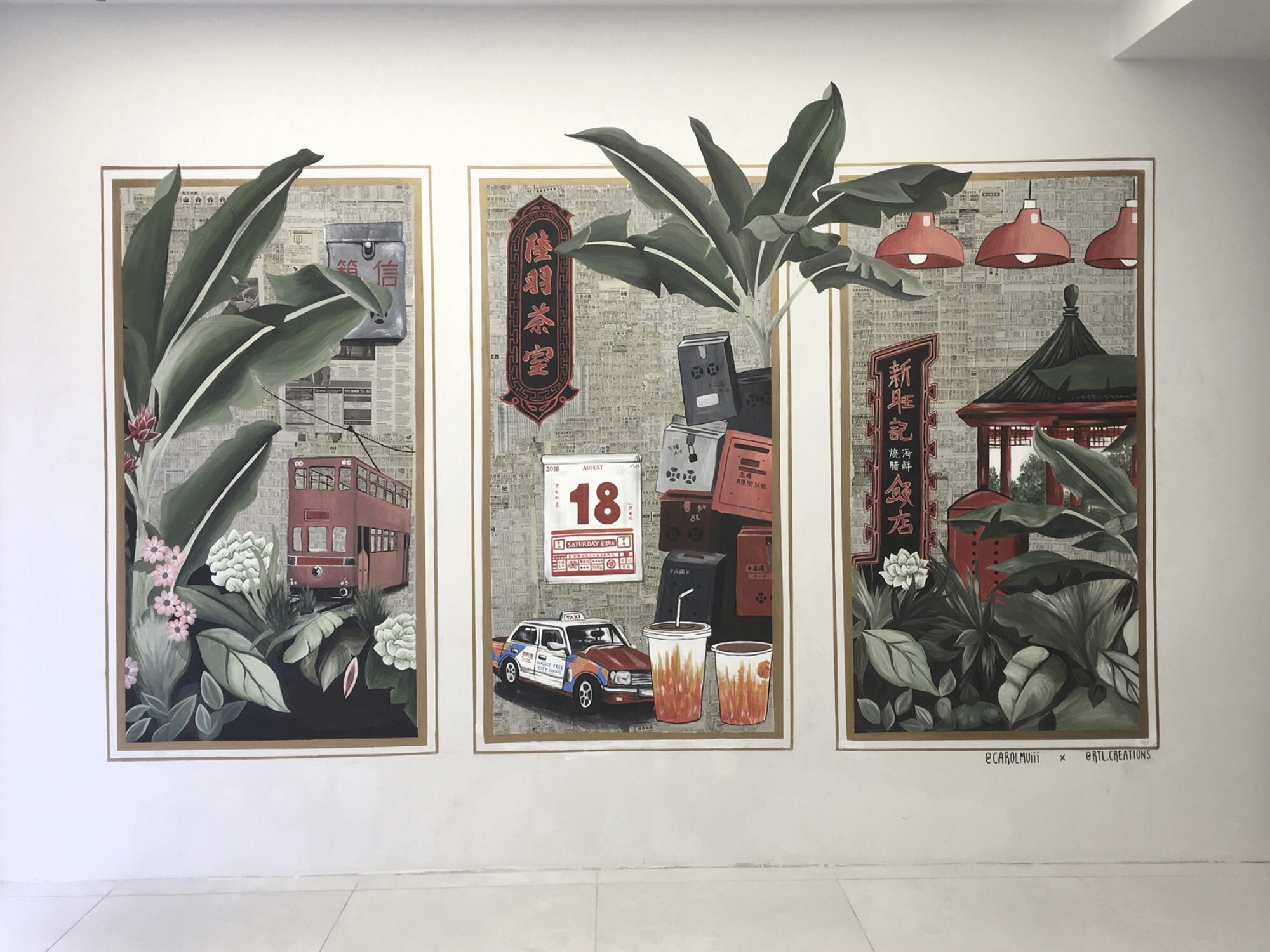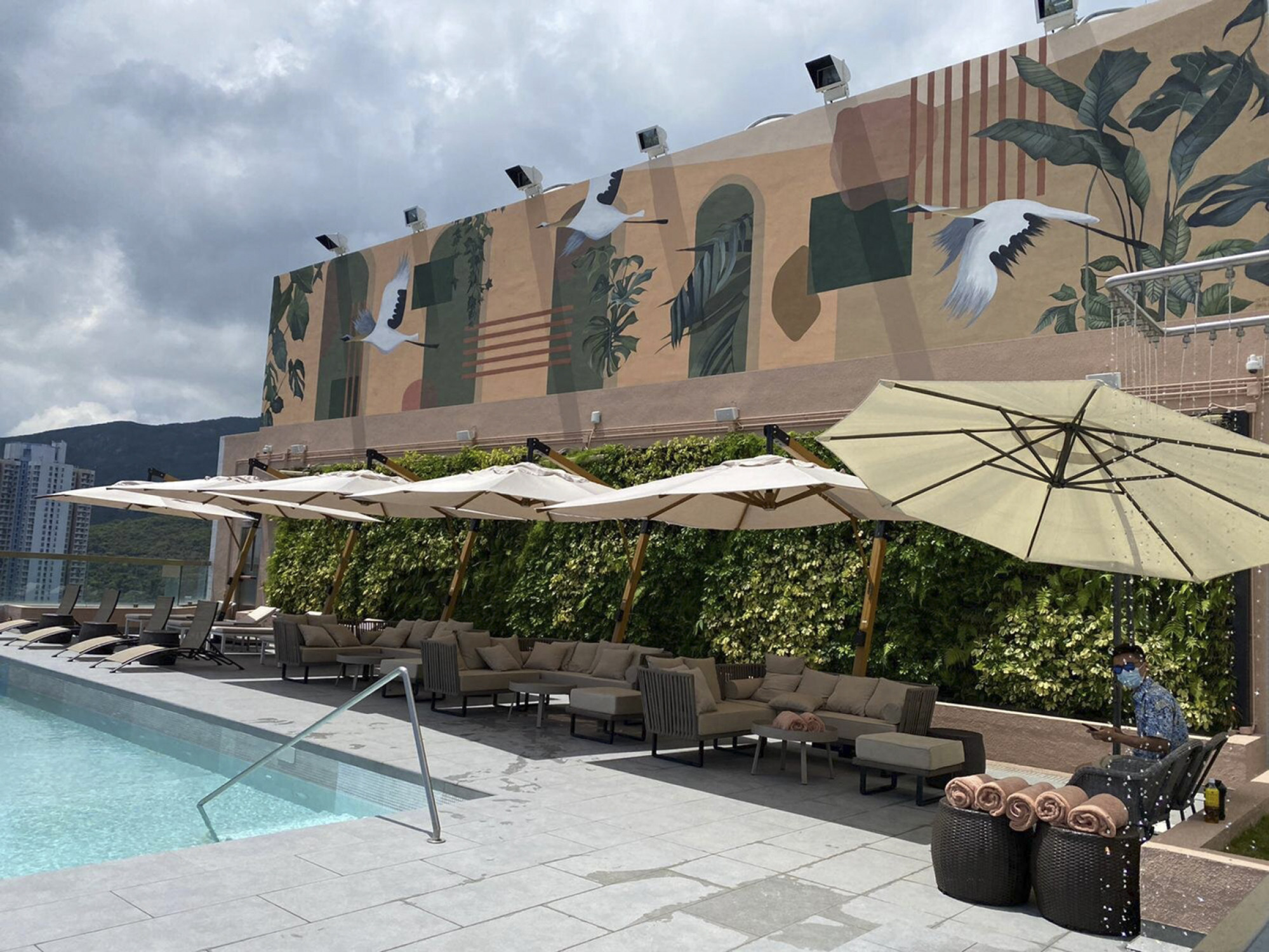
Hong Kong restaurant interior design embraces wall art, and it’s as Instagramable as the food and drinks
- In Hong Kong, murals are finding love on social media feeds and giving work to specialist painters whose art can be found inside city restaurants
- Fiery golden dragons adorn the walls of Qi – Nine Dragons in Tsim Sha Tsui. In Central, the walls of Italian hotspot Estro have the feel of an Italian villa
Unless you live under a rock, you will have seen that street art is everywhere in Hong Kong, from Sai Kung to Wong Chuk Hang to Central – where tourists patiently queue to take selfies with the art on the wall of the Goods of Desire store on Hollywood Road. Well, they did before anti-government protests and the pandemic kept them away.
Less obvious is the popularity of murals inside bars and restaurants. In the age of social media, it’s not enough for the food and drink to be photogenic – interiors must be Instagramable, too. Cool wall art is one of the most effective ways to achieve this.

Among them are the paintings at contemporary Italian hotspot Estro, in Central on Hong Kong Island. The space, inspired by the living rooms of Italian villas, is a swirl of earthy, autumnal tones and organic shapes, envisaged by architect and interior designer André Fu.
The murals, which adorn two dining alcoves, float above the tables, figurative abstractions in muted greens, blues and orange. Special matt-finish Italian plaster adds depth, texture and warmth to the cosy nooks.

“To me, hand-painted murals are synonymous with the designs of traditional salottos [living rooms], and they evoke a poetic silhouette that I am keen to bring to life at Estro,” says Fu. “We have also researched the works of Jean Cocteau to evoke a particular time and place within the overall expression, which I think is best captured by the murals.”
Bringing Fu’s vision to life is Elsa Jeandedieu, the go-to artist for high-end murals in Hong Kong. Unlike many self-taught local muralists, the French artist studied and trained to become a peintre-décorateur, a highly skilled trade with a long tradition in Europe. It encompasses a range of wall art, including frescoes, trompe l’oeil (a style of painting to create the illusion of real objects) and faux painting.
A talented painter such as Jeandedieu can produce astonishing marble, stone and wood-look finishes almost indistinguishable from the real thing.

When Jeandedieu moved to Hong Kong in 2009, “interior designers didn’t understand what I did”, she says. “In Paris, it’s slower but high quality, and everything has to be perfect. Here is very fast-paced. I couldn’t use the same paints or materials, and had to reinvent my work and adapt.”
With that in mind, Jeandedieu tries to steer clients to the right materials and finishes depending on the conditions and purpose. She often recommends acrylic paint for hospitality venues because “you can do a lot with acrylic. I use a patina that is a mix of varnish, water and acrylic, you can create layers, and it is easy to maintain.”

You can see her beautiful patina and layering techniques at venues as diverse as The Aubrey, a cocktail lounge atop the Mandarin Oriental hotel in Central, where painted cranes are offset by copper leaf for extra sheen; at Pure Yoga in Pacific Place in Admiralty, with its subtle abstractions and gradations of colour; and at Coffeelin, a cafe in Happy Valley meant to resemble an old Milanese bar, where faded Memphis-style patterns cover distressed walls.
Without a similar history of decorative painting in Hong Kong, many of the city’s muralists came to the profession by accident.

Wong volunteered so he could get his foot in the door as a muralist. Now his fiery golden dragons stand out almost as much as the restaurant’s harbour views.
Wong quickly grew his portfolio at a time when demand for murals was taking off. One of his largest creations is a 12-metre by 3-metre (39ft by 10ft) work at Shanghai Yu Yuan, a Michelin-recommended restaurant in Causeway Bay named after a historic garden in Shanghai. The client wanted a feature wall that captured the spirit of 1920s Shanghai, when the city was known as the “Paris of the East”.
With a clear brief and reference photos, Wong set about creating vivid scenes of ladies strolling, men eating and children playing in a garden, using simple lines and the bold colours common during that era.

To create such a large work, Wong says he used a projector to speed up the process and ensure it was in proportion.
“There’s some stigma to using a projector,” he admits, but he is undeterred. “If you have lots of time to create something, then fine. But you’ve got a job to do, and you need to make it look good, a projector saves so much time. Investing in a good projector is one of the best things I did.”
Rebecca Lin and Carol Mui, friends who work together under the banner #CreativeHustlers, prefer the technique of dividing a work on a grid. The self-taught muralists, who painted their first piece together in 2017, have a signature style – palm trees, ferns and other lush foliage – that’s in high demand.
“Greenery is good for business because it easily complements a lot of interiors, and it’s beautiful,” says Mui.

It’s a style that blends well with the design of The Arca, a new boutique hotel in Wong Chuk Hang in the south of Hong Kong Island. Potted shrubs line a feature wall at the rooftop infinity pool, and Lin and Mui’s mural appear as a natural extension of the real plants below.
In the hotel’s restaurant, a garden-themed mural connects the interior with a large terrace and lawn beyond.
When developing ideas for new projects, Lin and Mui individually think up concepts, then compare notes via video calls. “Our style is so similar and we work together so well that when we are executing a project, we’re literally side by side just going in between each other,” Lin says. “Sometimes we don’t even recognise who did what.”
Although murals are usually used as an accent, at Musubi Hiro they are everywhere. The relaxed izakaya beneath the Mid-Levels escalator in Central has a bold facade by Hong Kong-based Japanese artist “Taxa” (who also created murals for new restaurants Percy’s and Brooklyn Yakuza), while inside, there is wall-to-wall art by five design students from the Hong Kong Design Institute.

With such a diversity of artists and artworks, it’s apparent that there isn’t a single trend for murals. Artists agree, however, that social media is driving the popularity of murals. This has its drawbacks, with many clients requesting something that looks good on Instagram, with no brief and no idea of what they want. This can lead to lots of back and forth before landing on a design.
Luckily most clients provide a brief, and allow artists the creative freedom to spin their magic. As Jeandedieu explains: “I’m not a doctor, but my paintings can really brighten someone’s day. If I can bring something positive, colourful and joyful to people’s lives, that is the number one thing.”

